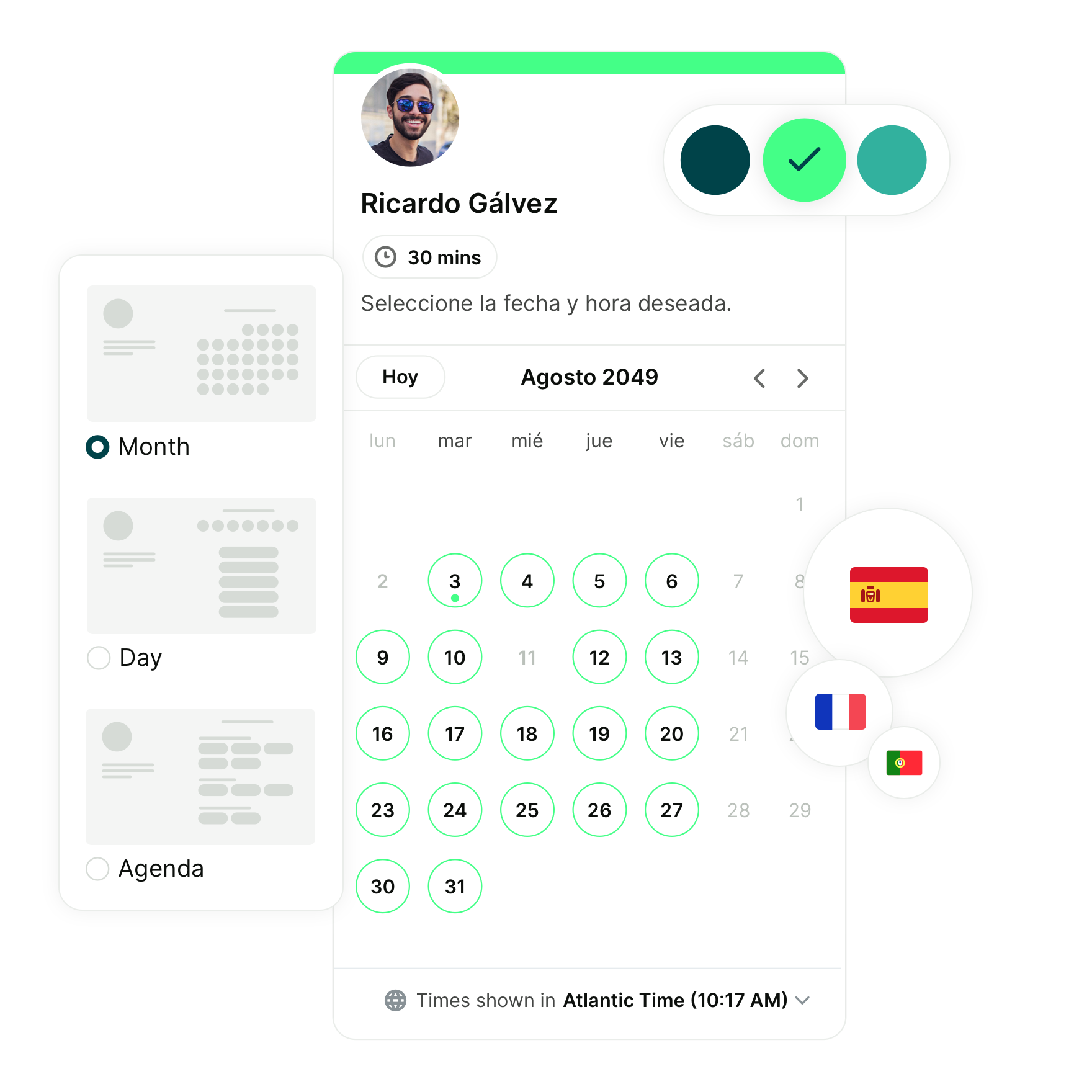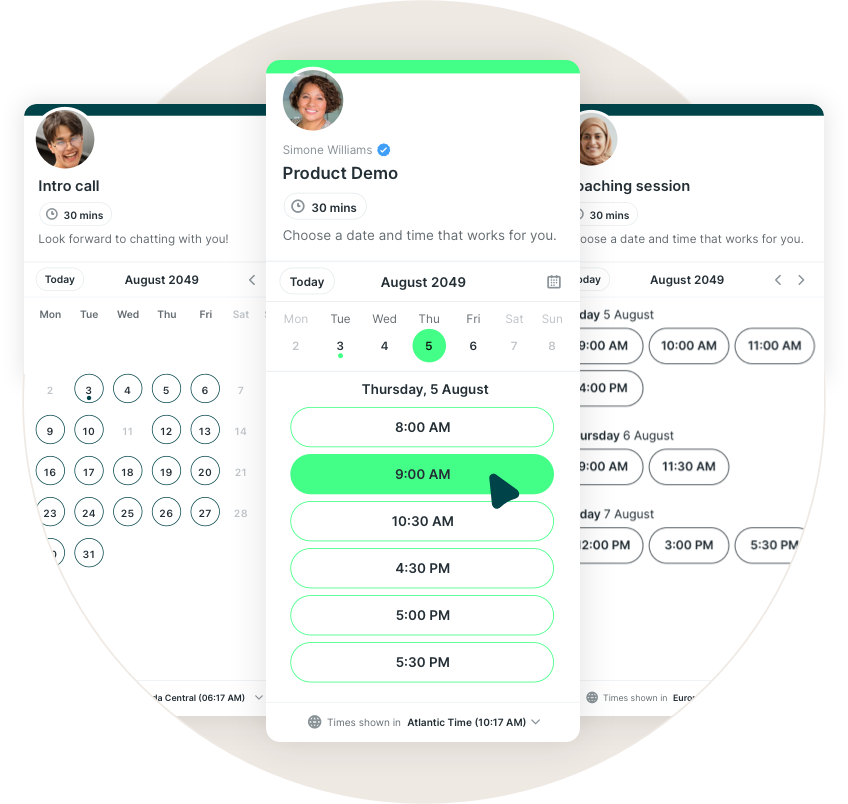Solo Consulting 101: How to Turn Your Expertise Into a Business
Everything you need to launch a successful solo consulting business—from defining your niche to landing your first clients.

Jordan Lee

Contents
- Understanding the solo consulting landscape: Trends and opportunities
-
Your step-by-step guide to starting a consulting business
- Step 1: Identify your niche and target audience
- Step 2: Define your services and value proposition
- Step 3: Set up your business basics
- Step 4: Price your consulting services strategically
- Step 5: Build your personal brand and online presence
- Step 6: Find and win your first clients
- Step 7: Manage projects and deliver outstanding results
- Overcome common challenges in solo consulting
- Success tips for new solo consultants
- Your solo consulting journey starts now
Ready to book more meetings?

You've got the skills. You've got the experience. And you're probably tired of making other people rich with your expertise.
If you've been daydreaming about breaking free from corporate life and building something that's truly yours, solo consulting might be your golden ticket. The best part? You don't need a fancy office, a huge team, or even a trust fund to get started.
Whether you're a marketing whiz, an HR guru, or that person everyone comes to for tech solutions, there's a path to turn your know-how into a thriving independent business. And honestly? Companies are hungry for specialists who can jump in, solve problems, and deliver results without the overhead of a big consulting firm.
Ready to explore what it takes to make the leap? Let's dive in.
Understanding the solo consulting landscape: Trends and opportunities
The solo consulting model is experiencing a notable surge—driven by evolving workforce trends, rising demand for specialized expertise, and a cultural shift toward entrepreneurial independence. Organizations today are increasingly bypassing traditional consulting firms in favor of agile, independent professionals who deliver tailored solutions with speed and precision.
Why solo consulting is on the rise:
- Remote-first mindset: The normalization of remote work has eliminated geographical barriers. Solo consultants can now serve a global client base, leveraging virtual tools to collaborate efficiently across time zones.
- Demand for agility and flexibility: Companies facing rapid change need nimble partners. Solo consultants offer just-in-time expertise without the overhead or rigidity of larger firms, making them ideal for strategic initiatives and project-based work.
- Professional autonomy: Many professionals are leaving corporate roles to regain control over their time, income, and impact. Solo consulting provides a pathway to career fulfillment, flexibility, and personal brand development.
High-potential niches for solo consultants:
- Digital marketing and brand strategy
- IT infrastructure, cybersecurity, and systems implementation
- HR compliance, talent management, and DEI strategy
- Financial modeling, budgeting, and operational forecasting
- Executive, wellness, and leadership coaching
Choosing a niche that aligns with both your expertise and market demand is essential for standing out and commanding premium rates.
Your step-by-step guide to starting a consulting business
Once you’ve decided to launch your solo consulting venture, the next challenge is knowing how to start—strategically and sustainably. Whether you're transitioning from a corporate role or turning freelance experience into a business, this guide walks you through every essential step.
From choosing a profitable niche to building your brand and landing your first clients, here’s how to lay the foundation for a successful and scalable consulting business.
Step 1: Identify your niche and target audience
The foundation of a successful solo consulting business is a well-defined niche—one that connects your strengths with a high-value client problem. Generalists struggle to stand out. Specialists get hired. When you zero in on a specific service for a specific audience, you build clarity, credibility, and demand.
Reflect inward: What do you bring to the table?
Start by identifying your most impactful skills and experiences:
- What results have you consistently delivered in past roles?
- What do people naturally seek your help or advice for?
- What types of problems energize and challenge you?
Look for patterns in your work history and personal strengths. These will guide you toward a niche where you can provide exceptional value.
Look outward: what does the market want?
Next, validate your direction with actionable research:
- Scan platforms like LinkedIn, Upwork, or Clarity.fm for consulting services in demand.
- Analyze competitors—what niches are saturated, and where are there gaps?
- Talk to potential clients about their biggest pain points.
- Monitor industry forums, newsletters, and Slack groups for recurring challenges and questions.
This process reveals what your target market is actively searching for and willing to pay for.
Define your niche with precision
Avoid vague labels like “marketing consultant.” Instead, aim for specificity that instantly communicates value:
- Broad: Marketing consultant
- Refined: Email funnel strategist for SaaS product launches
- Highly specific: Email marketing consultant for seed-stage B2B SaaS startups preparing their first launch
This level of clarity makes it easier to position yourself as an expert, tailor your messaging, and create irresistible service offerings.
|
Pro tip: The ideal niche hits three marks—your strengths, clear demand, and personal motivation. When these align, marketing feels easier and your value becomes obvious. |
Step 2: Define your services and value proposition
With your niche in place, it’s time to articulate exactly what you offer—and why it matters. This step transforms your expertise into marketable services that clients can easily understand, value, and buy.
Too often, new consultants list vague services like “strategy sessions” or “coaching” without highlighting the outcomes clients care about. Remember: people don’t buy hours—they buy results.
Clarify your service offerings
Start by outlining your core solutions:
- What specific services will you provide? (e.g., audits, workshops, implementation, ongoing advisory)
- Will clients engage you for one-off projects, retainer-based support, or a mix of both?
- How will you deliver your services—remotely, in-person, or through asynchronous deliverables?
Mapping out your services in clear formats helps you scope projects accurately and build scalable packages.
Position your services around outcomes, not just actions
Clients want to know what they’ll walk away with—not just what you’ll do. Frame each service in terms of its tangible benefits. For example:
- Instead of “marketing strategy session,” say “90-minute intensive to uncover and fix your #1 conversion bottleneck.”
- Instead of “HR consulting,” offer “custom onboarding system to reduce new hire ramp-up time by 50%.”
This shift makes your value obvious and sets you apart from generic consultants.
Craft a magnetic value proposition
Your value proposition is your core message—the bridge between your service and the client’s pain point. To write one that resonates, answer these three questions:
- What specific problem do you solve?
- Who do you solve it for?
- Why are you the best person to solve it?
Example: “I help early-stage SaaS startups convert trial users into paying customers by creating high-converting onboarding email sequences—so they can reduce churn and grow faster.”
This clarity becomes the foundation of your website copy, pitch decks, social bios, and sales conversations.
|
Pro tip: Test your value proposition with real people. If they immediately understand who you help and how, you’re on the right track. |
Step 3: Set up your business basics
With your niche and service offerings dialed in, the next step is setting up the operational and legal foundation for your consulting business. Even if you're starting lean or part-time, formalizing your business from the start builds professionalism, protects your interests, and positions you for long-term success.
Choose the right business structure
Your legal structure impacts taxes, liability, and how you operate. Common options for solo consultants include:
- Sole proprietorship: The simplest structure with minimal setup—but offers no personal liability protection.
- LLC (limited liability company): A popular choice for solo consultants that provides legal separation between your personal and business finances.
- S corporation: Ideal for consultants expecting higher income and seeking potential self-employment tax savings. Always consult a tax professional to determine if this is right for you.
Register your business and handle the paperwork
Once you choose a structure, make it official:
- Register your business name with your state or local government.
- Apply for an EIN (Employer Identification Number) from the IRS—it’s required to open a business bank account and file taxes.
- Set up a dedicated business checking account to keep finances clean and separate from personal expenses.
Set up your core systems and tools
Organized systems free up time and make you look more professional. At a minimum, you’ll need the following types of consulting software:
- Accounting software like QuickBooks, Wave, or FreshBooks for managing income and expenses.
- Invoicing and payment tools such as Stripe, PayPal, or HoneyBook to send invoices and get paid easily.
- A consulting contract template that covers scope of work, payment terms, timelines, confidentiality, and intellectual property rights. (Ideally, have this reviewed by a legal professional.)
- Scheduling software like YouCanBookMe to make it easy for existing clients and prospects to book time with you.
|
Pro tip: Even if you're just testing the waters or starting on the side, treating your consulting like a real business from day one builds confidence and credibility—with both you and your clients. |
Step 4: Price your consulting services strategically
Setting your consulting rates is one of the most pivotal—and often most nerve-wracking—decisions you’ll make. Price too low, and you risk undercutting your value and working unsustainably. Price too high without backing it up, and you may lose early opportunities. The goal is to anchor your pricing to the outcomes you deliver, not the hours you spend.
Know your pricing models
There’s no one-size-fits-all pricing strategy. Choose a model that aligns with the type of work you do and how your clients prefer to engage:
- Hourly rate: Straightforward, but can limit earnings and shift focus to time spent rather than results.
- Project-based pricing: Best for well-scoped deliverables. Enables margin control and clearer expectations.
- Monthly retainer: Ideal for ongoing advisory work or support. Provides consistent revenue and deepens client relationships.
- Value-based pricing: Ties your fee to the ROI or transformation you deliver. If you help a client recover $100K in lost revenue, a $10K fee becomes a smart investment.
Calculate your baseline rate
To avoid guessing, use this simple framework:
- Define your annual income target (e.g., $100,000).
- Estimate your billable hours (e.g., 1,000 hours per year if working 20 hours/week with time for admin and business development).
- Divide income by hours to find your base hourly rate (e.g., $100/hour).
Adjust this number upward based on demand, experience, or specialization. Over time, you may move away from hourly altogether in favor of outcome-driven pricing.
Create service packages to simplify sales
Packaging your services makes it easier for clients to buy—and for you to scale. Consider offering:
- Starter: A quick-win package or audit for first-time clients.
- Standard: A full engagement with defined deliverables and outcomes.
- Premium: A high-touch, ongoing service for strategic or long-term needs.
Spell out timelines, deliverables, and expected outcomes to minimize confusion and prevent scope creep.
Remember, not every client needs the same level of service, so it can make sense to offer tailored packages that include thoughtful discounts for consulting clients when appropriate.
|
Pro tip: Don’t apologize for your rates. You’re not just selling time—you’re selling your ability to solve complex problems faster and more effectively than clients can on their own. When you price with confidence and clarity, the right clients will recognize the value. |
Step 5: Build your personal brand and online presence
As a solo consultant, you are the brand. Clients aren’t just hiring a service—they’re hiring you: your expertise, your process, and your perspective. Your personal brand communicates who you help, how you help them, and why you’re the trusted choice—often before you ever speak with a prospect.
Lay the foundation of your brand
Your brand should reflect your professionalism, personality, and niche. Start with these core elements for marketing your business:
- Visual identity: Choose a clean, professional logo, a cohesive color palette, and modern typography. Consistency across your website, proposals, and social media builds recognition and trust.
- Messaging framework: Create a clear, benefits-focused positioning statement. Answer three questions at a glance: Who do you serve? What do you help them achieve? Why are you different?
This messaging becomes the core of your website, social bios, and sales conversations.
Build a conversion-focused online presence
You don’t need a complex website to win clients—just a strategic one. Here’s what to include:
- Homepage: Communicate your value proposition clearly, ideally in the first headline. Let visitors know exactly who you help and what outcome you deliver.
- Services page: Outline your offerings, packages, and the results clients can expect. Make it easy for potential buyers to understand and say “yes.”
- About page: Humanize your brand with your story, background, and values. Build trust by showing both competence and relatability.
- Contact page: Include a scheduling tool like YouCanBookMe to reduce friction and book discovery calls directly.
Don’t forget your LinkedIn profile—treat it like a landing page, not just a résumé. Use your headline and summary to communicate your niche, services, and the transformation you offer clients.
Establish credibility with content
You don’t need to be a thought leader on every platform—but you do need to show up where your ideal clients spend time. Start simple:
- Write blog posts that answer frequent questions or objections you hear in sales calls.
- Share bite-sized insights or client wins on LinkedIn to build awareness and trust.
- Offer a free downloadable resource (lead magnet) to grow your email list and nurture future leads.
|
Pro tip: Focus on being visible, not viral. A few pieces of clear, helpful content shared consistently will do far more for your business than chasing likes or trends. And if you need help choosing topics or getting started, check out our guide on how to use ChatGPT for business! |
Step 6: Find and win your first clients
Landing your first few clients is often the hardest part of launching your consulting business—but it’s also the most important. This early traction validates your offer, builds confidence, and sets the stage for referrals and growth. The good news? You don’t need a massive audience or paid advertising to start—you just need a clear message and consistent outreach.
Tap into your warm network first
Start with the people who already know and trust you. This low-pressure approach can lead to surprisingly fast wins.
- Reach out to former colleagues, mentors, and professional connections. Let them know who you help and how.
- Send personalized messages via email or LinkedIn—aim to offer value, not just ask for favors.
- Share a “launch post” on LinkedIn that explains your niche, services, and how people can get in touch. Make it easy to refer you.
These warm leads often become your first clients—or connect you to someone who will.
Create low-friction ways to engage
Help people experience your value without a big commitment:
- Offer a free consultation, discovery call, or mini audit to start conversations and build trust.
- Create an entry-level “starter service,” such as a 90-minute strategy session or one-time deliverable. It’s easier to say yes to a smaller engagement before moving into longer-term work.
Use targeted platforms to get in front of ideal clients
Go where your audience already spends time and seeks solutions:
- LinkedIn: Optimize your profile, connect with decision-makers, comment on relevant posts, and share content consistently.
- Upwork or Clarity.fm: These platforms attract businesses actively looking for consulting help—perfect for building early momentum.
- Niche communities: Join industry-specific Slack groups, Facebook groups, or online forums. Be helpful, not salesy. Answer questions and share insights to build credibility organically.
Build trust with early wins
Even small projects can fuel your credibility and marketing:
- Ask happy clients for testimonials or LinkedIn recommendations right after delivering value.
- Turn successful engagements into brief case studies that show your process and results.
- Use real conversations to guide your content—write blog posts or social updates that answer common questions your audience is asking.
|
Pro tip: You don’t need everything figured out to start selling. As long as your offer is clear and your intent is genuine, begin outreach now. Every conversation is a chance to refine your pitch, uncover new opportunities, and land that first yes. |
Step 7: Manage projects and deliver outstanding results
Winning a client is an important milestone—but keeping them happy is what sustains your business. In consulting, your reputation is everything. Delivering consistent, high-quality results builds trust, earns referrals, and turns one-off projects into long-term relationships.
Start with a seamless onboarding experience
First impressions matter. Create a structured, confident onboarding process that sets the tone for a smooth engagement:
- Send a clear welcome email or proposal recap outlining what was agreed upon.
- Define key milestones, deliverables, and timelines in writing.
- Use an intake form to collect necessary background, goals, and context.
This eliminates confusion and ensures both you and the client are aligned from day one.
Set clear expectations and communication norms
Boundaries and transparency protect both parties—and keep projects on track:
- Clearly define the scope of work. Spell out what’s included, what’s not, and how change requests will be handled.
- Agree on communication preferences. Will you check in weekly via Zoom? Use Slack for quick updates? Clarify early.
- Use a formal contract to outline timelines, deliverables, payment terms, and revision policies. This prevents scope creep and builds trust.
Stay organized with simple tools
You don’t need a full tech stack to stay professional—just the right essentials:
- Project management: Use Trello, Asana, or Notion to track tasks and deadlines.
- Scheduling: Tools like YouCanBookMe eliminate the friction of back-and-forth emails.
- File sharing: Keep documents organized in Google Drive or Dropbox for easy collaboration.
Organization creates a smoother experience for clients—and gives you the headspace to focus on results.
Deliver more than just the deliverables
Great consultants go beyond the checklist. They make the client feel supported, informed, and empowered.
- Be proactive. Provide regular updates, even if they’re brief.
- Communicate the “why” behind your work—not just what you did, but how it supports the client’s goals.
- Make yourself easy to work with. Responsiveness and clarity go a long way in building long-term relationships.
Gather feedback and create referral momentum
Your best marketing comes from satisfied clients. Make it easy for them to advocate for you:
- Ask for feedback at the end of each engagement. Learn what worked—and where you can improve.
- Request a testimonial or a LinkedIn recommendation while the experience is still fresh.
- Send a follow-up email 30–60 days later to check in, gather results, and explore future opportunities.
|
Pro tip: Don’t just deliver the work—own the outcome. The consultants who get rehired and referred are the ones who make clients feel supported, respected, and understood. |
Overcome common challenges in solo consulting
Even the most experienced consultants face bumps in the road. The difference between a thriving solo business and a stressful one often comes down to preparation. Instead of reacting to problems as they arise, successful consultants build systems that help them respond with confidence.
Here are five of the most common consulting challenges—and how to handle them like a pro:
1. Feast-or-famine income cycles
The challenge: One month you're slammed, the next you're scrambling for leads.
The fix: Build a consistent lead generation routine—even when you're busy. Block time each week for marketing activities like outreach, networking, content creation, or nurturing your email list. Consider offering retainers or ongoing service packages to smooth out revenue and reduce dependency on one-off projects.
2. Scope creep and boundary issues
The challenge: Clients ask for “just one more thing,” and suddenly the project doubles in size.
The fix: Always use a signed agreement that clearly outlines deliverables, timelines, and revision limits. When new requests pop up, respond professionally with options for add-on services. Clarity upfront protects your time and your client relationship.
3. Isolation and burnout
The challenge: Working solo can feel, well... solo. Long hours and no feedback loop can lead to mental fatigue.
The fix: Join a community of fellow consultants or freelancers—whether it’s a mastermind group, Slack channel, or local meetup. Block off regular no-client days, take real breaks, and treat rest like a business priority. Sustainability beats hustle in the long run.
4. Underpricing or overdelivering
The challenge: You finish the project exhausted and underpaid.
The fix: Track how much time you actually spend on each project—even if it’s flat-fee. This helps you spot patterns and adjust pricing in future proposals. Revisit your rates quarterly and compare them to market benchmarks to ensure you're charging what you're worth.
5. Inconsistent systems and workflows
The challenge: You’re reinventing the wheel with every new client.
The fix: Standardize your processes with templates—for proposals, onboarding emails, reports, and wrap-ups. Use tools like Dubsado, Zapier, or Notion to automate repetitive tasks and stay organized. Consistent systems make your work feel lighter and more professional.
|
Pro tip: Write down your top three recurring challenges. Then build one small system or boundary to address each. Bit by bit, you’ll create a consulting business that’s not just profitable—but predictable and sustainable. |
Success tips for new solo consultants
Solo consulting offers freedom, flexibility, and the chance to do meaningful work on your own terms. But success doesn’t happen by luck—it comes from treating your consulting practice like a real business from the start. These proven habits and best practices will help you build momentum, stay consistent, and grow with confidence.
1. Focus on outcomes, not just deliverables
Clients don’t hire consultants to fill time—they hire you to solve real problems. Shift your mindset from “what will I do?” to “what will they achieve?” Whether you’re creating a strategy, audit, or training, always tie your work to measurable results. It helps you build trust, stand out from competitors, and confidently justify your rates.
2. Market yourself even when you’re booked
Visibility creates opportunity. Set aside dedicated time each week for marketing activities, even during busy seasons. Post insights on LinkedIn, publish blog articles, or send a quick email to your list. Your future clients are watching—and when the timing is right, you’ll be top of mind.
3. Build repeatable systems early
Efficiency scales trust. From proposals and onboarding to project updates and wrap-up emails, create templates and workflows that save time and deliver a consistent client experience. Automate what you can with tools like Calendly, Zapier, or Dubsado, and revisit your systems quarterly to improve them.
4. Keep learning to stay sharp
Consulting trends shift quickly. Set yourself apart by committing to ongoing learning. Take relevant courses, attend virtual workshops, or join communities where new ideas are shared. Investing in your development makes you more valuable to clients—and keeps your confidence high.
5. Leverage social proof and referrals
Happy clients are your best marketers. After a project wraps, send a friendly request for a testimonial or LinkedIn recommendation. Even a few sentences can powerfully boost your credibility. When appropriate, ask if they know anyone else who could benefit from your services.
|
Pro tip: You’re not just a freelancer—you’re a business owner. Make decisions strategically, act like a partner in your clients’ success, and approach your work with the polish of a seasoned pro. That mindset is what separates thriving consultants from struggling ones. |
Your solo consulting journey starts now
You already have what it takes—real expertise, a hungry market, and accessible tools. Yes, there will be challenges, but the freedom of building something that's fully yours is worth it. No more corporate politics or arbitrary deadlines—just meaningful work with clients who value your impact.
Don’t wait for the perfect moment. The best way to learn is by doing, and your future clients are already looking for the solutions only you can offer.
FAQ
How much does it cost to start a solo consulting business?
Startup costs are low compared to most businesses. You can get started for under $1,000 by covering the basics: business registration, a simple website, accounting software, and professional branding. Your biggest investment will be your time.
Do I need a website to get started?
Not at first. If your LinkedIn profile clearly communicates who you help and how, you can start landing clients without a site. That said, a simple website builds credibility and gives prospects a central place to learn about your services.
What if I don’t have any clients yet?
Can I run a consulting business part-time?
How do I know if I’m ready to be a consultant?
If you have valuable expertise, a desire to solve problems, and a willingness to learn the business side (like pricing and sales), you’re ready. You don’t need perfection—just a plan and the courage to start.
Pro tip: Every successful consultant started with questions and uncertainty. Clarity comes from action. Take the next small step—and momentum will follow.
Subscribe to our newsletter
Get productivity tips, news, articles and resources.
Written by
Jordan Lee
Jordan Lee is a business consultant and writer who helps solo professionals turn their expertise into thriving businesses. They specialize in positioning, client acquisition, and sustainable growth for independent consultants.



